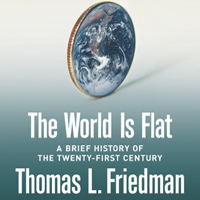 The World is Flat: A Brief History of the Twenty-First Century by Thomas L. Friedman, Pulitzer Prize-winning author, journalist, and New York Times op-ed contributor was the winner of the first edition of the Financial Times Business Book of the Year Award in 2005.
The World is Flat: A Brief History of the Twenty-First Century by Thomas L. Friedman, Pulitzer Prize-winning author, journalist, and New York Times op-ed contributor was the winner of the first edition of the Financial Times Business Book of the Year Award in 2005.
The World is Flat is an essential update on globalization, its discontents — and its successes. The lightning-swift advances in technology and communications put people all over the world in touch as never before — creating an explosion of wealth in India, China and elsewhere, turning eBay hobbyists sitting in their living rooms into prosperous international merchants…and challenging the rest of us to run even faster if we hope to keep pace.
The playing field is being levelled, the world is becoming flat. This is Globalization 3.0. In Globalization 1.0, which began around 1492, the world went from a size large to size medium. In Globalization 2.0, the era that introduced us to multinational companies, it went from size medium to size small. And then around 2000 came Globalization 3.0, in which the world went from being small to tiny. There’s a difference between being able to make long distance phone calls cheaper on the Internet and walking around Riyadh with a PDA where you can have all of Google in your pocket. It’s a difference in degree that’s so enormous it becomes a difference in kind.
The World is Flat by Thomas Friedman: the 10 Great Levellers
According to the author 10 types of Great Levellers operated (and keep operating), the flattening.
Supply chains, for example, are incredible flatteners: in order to work, they need to design very effective supply chain algorithms to create systems with customs offices around the world. In some sense, Friedman claims that the world is a gigantic supply chain and terrorism is nothing more than a mutant supply chain. Here’s the entire list of the Great Levellers:
-
- Fall of the Berlin Wall The events of November 9, 1989, tilted the worldwide balance of power toward democracies and free markets.
- Netscape IPO August 9, 1995, offering sparked massive investment in fibre-optic cables.
- Work flow software The rise of apps from PayPal to VPNs enabled faster, closer coordination among far-flung employees.
- Open-sourcing Self-organizing communities launched a collaborative revolution.
- Outsourcing Migrating business functions to India saved money and a third world economy.
- Offshoring Contract manufacturing elevated China to economic prominence.
- Supply-chaining Robust networks of suppliers, retailers, and customers increased business efficiency. See Wal-Mart.
- Insourcing Logistics giants took control of customer supply chains, helping mom-and-pop shops go global. See UPS and FedEx.
- In-forming Power searching allowed everyone to use the Internet as a “personal supply chain of knowledge.” See Google.
- Wireless Like “steroids,” wireless technologies pumped up collaboration, making it mobile and personal.
| Title | The World Is Flat: A Brief History of the Twenty-first Century |
| Author | Thomas L. Friedman |
| Published | April 18th, 2006 |
| Publisher | Farrar, Straus and Giroux (NY) |
| ISBN | 0374292795 |
| Language | English |
| Literary Awards | Audie Award for Non-Fiction Unabridged (2006), Financial Times and McKinsey Business Book of the Year (2005) |
